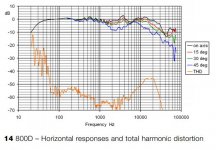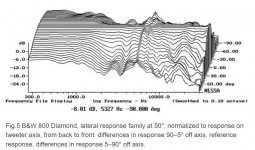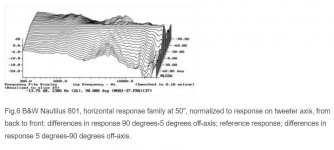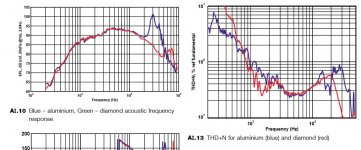Totally quote you. The first nautilus series were created with final sound in mind. Latest series with sales and marketing hypes and it shows on the actual final sound! Too bad!! I wonder what have been like if they would have actually improved significantly their signature series, which up till date, still easily competes with the best speakers out there.
This is from the 800D development paper.
Distortion is quite low to below 100Hz (<0.5%) but rises steeply below 70Hz. (-40dB = 1% THD.)
Attachments
Last edited:
Actually, not many people have suggested that.
The importance of off-axis response is beyond doubt but is also very room specific. The response as heard in the listening chair is definitely the most important metric for perceived tonal balance, but is not necessarily closely correlated with a near-field measurement that you might see in Stereophile or Hi-fi News.
It's worth noting the enormous difference between the Stereophile and Hi-Fi news measured response of the 802D2 and D3.
Which begs the question, are both flawed, and if not which is correct?
Please let me know which AES paper or the scientific research that suggests FR to be flat at the listning position. All I have read so far doesn't suggest that in fact.
Please let me know which AES paper or the scientific research that suggests FR to be flat at the listning position. All I have read so far doesn't suggest that in fact.
TBH, the only papers I've read are related to pro recording (industry) and all of them suggest a flat target response for far field monitoring.
I also have two dsp based correction packages, and not surprisingly both of them attempt to create a flat response at the listening position.
That doesn't mean that flat is optimum of course, but what other target makes logical sense?
If you can provide said links to scientific research specific to domestic listening it would be much appreciated.
I just browsed through some images of B&W and it is difficult to find models without fundamental flaws on first sight. Or, let´s say, designs which correlate with my understanding of what potentially could be a good speaker.
Take the Nautulus. Would B&W never have heard of Olson´s work on diffraction?
https://www.google.nl/search?q=olso...wiOXOAhUrLcAKHajNBCUQsAQIMg&biw=1647&bih=1135
Just one of those B&W boxes with in-your-face flaws. And the flagship model too.
The 800 development paper devotes a few paragraphs to the issue of diffraction and the development of the marlin head which combines the benefits of a sphere and tapered tube.
see appendix V. Sphere/Tube Midrange Enclosure
B&W 800 Development Paper - Documents
Last edited:
Please let me know which AES paper or the scientific research that suggests FR to be flat at the listning position. All I have read so far doesn't suggest that in fact.
Where do you listen when you want to do a serious listening session? Just curious....
In my opinion the most important spot is the center listening position, why would anybody want to listen from the kitchen and expect to have any fidelity???
I listen from two main locations. One far field and one more near field. I value a uniform off axis response very highly.
And then in the other household systems, where casual listening is all they are used for, having a great off axis performance is critical for room wide performance.
And then in the other household systems, where casual listening is all they are used for, having a great off axis performance is critical for room wide performance.
This is from the 800D development paper.
Distortion is quite low to below 100Hz (<0.5%) but rises steeply below 70Hz. (-40dB = 1% THD.)
Art,
Thank you for linking to the development paper and the FR. At the best listening angle, +/- 4 dB, that is just not up to modern standards. Some components seem to be very nice, especially the tweeter. I would love to put it on the bench. The yellow thing in the middle was a bad idea from the beginning. The ripples in the FR in the mid region are caused by something! Most likely diffraction though. A ball is optimum according to Olson and it is, but not just any ball. It has to have a certain minimum size to work. B&W's balls are too small. The huge dip of the blue line at 45 degrees shows that the alleged flexible size of the midrange moving diaphragm, smaller at higher frequencies, just doesn't work. It behaves like any over sized midrange does. The power response of this speaker is ragged, but the dip around 2-3kHz may be appreciated by some.
Distortion above 60 dBis commendable though. But it doesn't specify at which SPL. Many speakers can do this at 80 dB @ 1 meter or so.
I listen from two main locations. One far field and one more near field. I value a uniform off axis response very highly.
And then in the other household systems, where casual listening is all they are used for, having a great off axis performance is critical for room wide performance.
I think I understand what you mean. Let me first address the casual listening: hopefully we won't use 800s and lots of $$ for casual listening. In that case, demands are completely different and a main one is hat it has to diffuse the sound as much as possible.
Regarding the two position, I believe, correct me if I am wrong, you speak from the perspective of speaker developer standpoint, which I think is what you enjoy doing.
Me, I design electronics, so whenever I listen, I need to be concentrated in the center to evaluate if soundstage dimensions transparency and other parameters have improved or not.
Certainly I can't determine that with much accuracy being in any spot other than the center.
Now, from an audiophile standpoint who wants to have fully 2-ch experience, and spends lots of $$ on equipment, I doubt they will want to listen off center.
Everything is a trade off and I guess everyone needs to choose based on what is most important for them.
In my case, I really value the center position any order spot will not make much sense to me.
Granted, it would be very nice and desirable if the sweet spot for the b&w would be a little wider so that if 3 people are listening in the center they all perceive the same thing, provided this widening wouldn't affect definition on the sound.
Unfortunately this seems to not be possible with the 800 which is a little bit limiting. But in the end if you are dead on the center, you will get great listening experience.
Art,
Thank you for linking to the development paper and the FR. At the best listening angle, +/- 4 dB, that is just not up to modern standards. Some components seem to be very nice, especially the tweeter. I would love to put it on the bench. The yellow thing in the middle was a bad idea from the beginning. The ripples in the FR in the mid region are caused by something! Most likely diffraction though. A ball is optimum according to Olson and it is, but not just any ball. It has to have a certain minimum size to work. B&W's balls are too small. The huge dip of the blue line at 45 degrees shows that the alleged flexible size of the midrange moving diaphragm, smaller at higher frequencies, just doesn't work. It behaves like any over sized midrange does. The power response of this speaker is ragged, but the dip around 2-3kHz may be appreciated by some.
Distortion above 60 dBis commendable though. But it doesn't specify at which SPL. Many speakers can do this at 80 dB @ 1 meter or so.
Vac, Re distortion, from my own testing I can confirm that it's likely correct for 1 watt / 1m. The Kevlar FST is a very low distortion mid driver.
Re FR, B&W optimise their floorstanders for normal far field listening so the end result is better than near field measurements suggest. Using Dirac software and my Earthworks mic, the response averaged over the 2m length of the sofa (prior to crossover mods) was essentially flat apart from a dip at 2-3kHz, and of course some expected room boundary gain in the bass.
The dip in the presence region isn't just a function of FST beaming though. See the attached lateral response measurements of the 800 diamond Vs the older Nautilus 801. Both speakers use the same sized FST mid and the FST low pass filter network is identical. Both tweeters are crossed over at 4kHz. The only change is the electrical HP feeding the tweeter, and the additional 90 degrees of mechanical alignment.
The Nautilus range employed a 3rd order crossover with the tweeter set forward by a distance equivalent to 90 degrees at 4kHz, whereas the Diamond range uses a first order network with the tweeter moved forward by a full 180 degrees @ 4kHz. This is what causes the uneven response on and off axis - in conjunction with the peak at 4kHz which is partly from the controlled FST driver break-up. Below 3kHz the tweeter generates destructive interference at the listening height, and because the polar response is much wider than the FST's at 2kHz, the interference is more pronounced at >30 degrees off axis, laterally as well as vertically - below the listening height .
IMO, the dip in the power response in the 2-3kHz is a little too excessive with the diamond range. Sure, a little dip is nice for classical music, and is also catered for by most recording studios, but > 3dB in the far field is excessive IMHO.
Attachments
I am completely ignorant on this and watch your amazing measurements and findings with big amaze....but...could it be this the reason for which Nautilus series sounds better than the Diamond's?
I am completely ignorant on this and watch your amazing measurements and findings with big amaze....but...could it be this the reason for which Nautilus series sounds better than the Diamond's?
By process of elimination, it can't really be anything else.
See the attached measurements of the old and new tweeter. Aside from slightly lower distortion down low and above 20kHz, the diamond tweeter is essentially identical within the audible passband.
I doubt you would be able to hear any difference at all if you ever did upgrade your Signature tweeters to the Diamond version.
Your wallet would be a little lighter though of course.
Attachments
TBH, the only papers I've read are related to pro recording (industry) and all of them suggest a flat target response for far field monitoring.
I also have two dsp based correction packages, and not surprisingly both of them attempt to create a flat response at the listening position.
That doesn't mean that flat is optimum of course, but what other target makes logical sense?
If you can provide said links to scientific research specific to domestic listening it would be much appreciated.
I'm from pro audio industry, and I have kept reading AES papers, and no paper support your claim as far as I know. Actually, music mixing room and mastering studios do not have flat response at all, and if you have flat response at your listening position like anechoic chamber, most of the recording would not sound as intended.
I did quick Google search, and found at least 2 papers says flat response at the listening position is not optimal for home audio, and these papers do not contradict what I have read. I believe this is a common sense among pro audio people.
http://www.aes.org/tmpFiles/elib/20160829/17839.pdf
http://www.petoindominique.fr/pdf/T...ve Evaluation of Room Correction Products.pdf
It is true that automatic DSP based correction can be more harm than good.
A funny thing is the second paper above shows B&W N802 Frequency response with "sound power problem" note. I think it is a JBL related paper, Lol.
I'm from pro audio industry, and I have kept reading AES papers, and no paper support your claim as far as I know. Actually, music mixing room and mastering studios do not have flat response at all, and if you have flat response at your listening position like anechoic chamber, most of the recording would not sound as intended.
I did quick Google search, and found at least 2 papers says flat response at the listening position is not optimal for home audio, and these papers do not contradict what I have read. I believe this is a common sense among pro audio people.
http://www.aes.org/tmpFiles/elib/20160829/17839.pdf
http://www.petoindominique.fr/pdf/T...ve Evaluation of Room Correction Products.pdf
It is true that automatic DSP based correction can be more harm than good.
I've read the Toole paper previously, and it is in fact a paper I would use to support the ideal of a flat target response.
Departures from flat are only justified when intended to reverse equalisation applied during the recording / mastering phases, designed to correct for average bad speakers. So you need to be specific about the reference on which the target response is based.
The extract below is relevant to our discussions.
In normal rooms the on-axis frequency response is
not the dominant physical factor. However, the direct
sound has a high priority in perception, establishing
a reference to which later arrivals are compared
in determining such important perceptions as
precedence effect (localization), spatial effects, and
timbre. In this example, the poor off-axis performance
dominated the in-room measurements and
in listening tests caused audible timbral degradation.
Equalization of the room curve will destroy
the only good performance in the loudspeaker—the
on-axis/direct sound response. Equalization cannot
change loudspeaker directivity; the remedy is a better
loudspeaker
Toole's conclusion is actually slightly flawed because he assumes that room correction is applied when the speakers are on-axis to the listening position.
If we take his example speakers and direct them so that they're beamed 30 degrees either side of the listener, when eq is applied, the direct response and room response will be closely matched. This is the logical method to correct a speaker with an off-axis anomaly.
WRT B&W 802N or D, and speakers with similar off-axis power dips at 2-3 kHz (which includes most 2-way designs), correction can be applied, or as I've done, the room can be acoustically treated such that the room curve more closely follows the near field / direct response.
Last edited:
I think I understand what you mean. Let me first address the casual listening: hopefully we won't use 800s and lots of $$ for casual listening.
You can use whatever you like for casual listening if you like. My main system is hooked up to my main PC with the monitor between the speakers. This is my nearfield setup and I use it pretty much everyday. Whether or not you call this casual listening I don't know but to me I want the sound quality in this location to be as good as in the farfield one. The farfield one is the one that you'd call the serious listening spot where eyes closed happens 🙂
In that case, demands are completely different and a main one is hat it has to diffuse the sound as much as possible.
You do not wish to the diffuse the sound at all, what you ideally want is a speaker that has it's directivity controlled, such that it throws sound out evenly, to the area that you want to have sound in.
Regarding the two position, I believe, correct me if I am wrong, you speak from the perspective of speaker developer standpoint, which I think is what you enjoy doing.
Yes I enjoy doing that but I am actually speaking from a listening perspective and what is required for an optimal listening experience regardless of what you are doing with the system, or what the room might be like.
Now, from an audiophile standpoint who wants to have fully 2-ch experience, and spends lots of $$ on equipment, I doubt they will want to listen off center.
Listening off centre is terrible from any perspective and should be avoided at all costs imo. And this is for any system, anytime, any place!
Everything is a trade off and I guess everyone needs to choose based on what is most important for them.
From a hifi perspective you aren't really trading off anything for your good off axis response and even power response. It just requires good design choices. Certainly the biggest trade off is price as you may not be able to achieve everything with a tight budget.
In my case, I really value the center position
Me too. Central image stability is one of the most important aspects of a good system, at least imo.
Granted, it would be very nice and desirable if the sweet spot for the b&w would be a little wider so that if 3 people are listening in the center they all perceive the same thing, provided this widening wouldn't affect definition on the sound.
This is what correctly setup and designed waveguide systems help with.
Unfortunately this seems to not be possible with the 800 which is a little bit limiting. But in the end if you are dead on the center, you will get great listening experience.
Indeed.
I've read the Toole paper previously, and it is in fact a paper I would use to support the ideal of a flat target response.
Departures from flat are only justified when intended to reverse equalisation applied during the recording / mastering phases, designed to correct for average bad speakers. So you need to be specific about the reference on which the target response is based.
The extract below is relevant to our discussions.
In normal rooms the on-axis frequency response is
not the dominant physical factor. However, the direct
sound has a high priority in perception, establishing
a reference to which later arrivals are compared
in determining such important perceptions as
precedence effect (localization), spatial effects, and
timbre. In this example, the poor off-axis performance
dominated the in-room measurements and
in listening tests caused audible timbral degradation.
Equalization of the room curve will destroy
the only good performance in the loudspeaker—the
on-axis/direct sound response. Equalization cannot
change loudspeaker directivity; the remedy is a better
loudspeaker
Toole's conclusion is actually slightly flawed because he assumes that room correction is applied when the speakers are on-axis to the listening position.
If we take his example speakers and direct them so that they're beamed 30 degrees either side of the listener, when eq is applied, the direct response and room response will be closely matched. This is the logical method to correct a speaker with an off-axis anomaly.
WRT B&W 802N or D, and speakers with similar off-axis power dips at 2-3 kHz (which includes most 2-way designs), correction can be applied, or as I've done, the room can be acoustically treated such that the room curve more closely follows the near field / direct response.
I am afraid that you would misunderstand these papers and how EQ works. Those 2 papers clearly suggest that target response is not flat at the listening position.
Also, EQ can't match room response and direct response. Only the physical solutions, room acoustic treatment and off axis response can match them. And, the bass response can't be changed even if your listening position is off axis or on axis.
Mixing and mastering are not for correcting for average "bad" speakers, but they are for reasonably "good" listening environment.
I'm very interested in what kind of pro audio papers you got your ideas from... Actually, I decided I'm not going to reply your post until you show me the paper, because I don't want to argue with someone on the forum, and the only reason I kept posting is I just want to see the paper you had suggested before.
edited
Last edited:
Actually the mastering room is mimicking the reasonably "good" listening environment.
Ted Jensen uses B&W 800D in his mastering room, although he plays back very quietly.
Ted Jensen uses B&W 800D in his mastering room, although he plays back very quietly.
I'm not sure I'm reading it all, but with (and only with) room treatment, EQ works a lot more than people think. You can in fact minimize (some would say eliminate) room resonances this way.
Something about minimum phase yada yada yada. In any event, there's good papers and I've done it myself. Works a treat.
Best,
Erik
Something about minimum phase yada yada yada. In any event, there's good papers and I've done it myself. Works a treat.
Best,
Erik
I'm not sure I'm reading it all, but with (and only with) room treatment, EQ works a lot more than people think. You can in fact minimize (some would say eliminate) room resonances this way.
Something about minimum phase yada yada yada. In any event, there's good papers and I've done it myself. Works a treat.
Best,
Erik
What I don't understand is, people spend a lot of money trying to listen to high end analog through fully analog masters and mastering material to get away from digital artifacts, then here we consider a digital signal processor as the solution to room problems, when in the reality it is introducing problems that are IMO far bigger than room resonances that can and should be taken in care by actual room treatment devices.
Digital playback system has tried in the course of the decades to eliminate the digital sound as well.
Why introducing an extra digital signal processing?
By process of elimination, it can't really be anything else.
See the attached measurements of the old and new tweeter. Aside from slightly lower distortion down low and above 20kHz, the diamond tweeter is essentially identical within the audible passband.
I doubt you would be able to hear any difference at all if you ever did upgrade your Signature tweeters to the Diamond version.
Your wallet would be a little lighter though of course.
That is a great explanation. This would prove the problem is not with the diamond tweeter but rather with the aspect you mentioned previously.
Then I ask, what is the big advantage of an expensive diamond tweeter or what could be done better in terms of material used for that transducer?
- Home
- Loudspeakers
- Multi-Way
- B&W Signature 800 upgrade diamond tweeter



